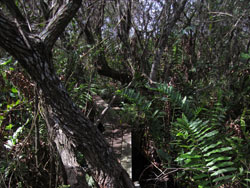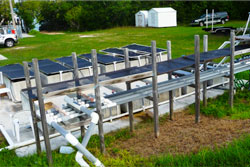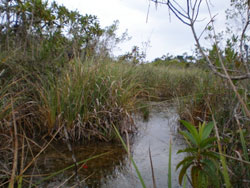Hydrology, Phosphorus Dynamics and Plant-soil Interactions in Everglades Tree Islands

In the Everglades, tree islands are considered characteristic of the ecological “health” of the landscape. Phosphorus (P) levels in upland tree island soils are greater than 100 times higher than P in adjacent marsh soils. Of primary concern is conservation of tree island habitat and maintaining tree island soil P to prevent P enrichment of local marsh communities. In this project, we are relating tree island community structure, hydrology and hydrogeochemical characteristics on four tree islands that vary along hydrologic and disturbance gradients to help further define characteristics of “healthy” tree islands and to refine tree island monitoring and performance measures.…Read more about this project
Soil Carbon Responses to Salt Water Intrusion from Projected Sea-level Rise

The interlinked biological processes that drive carbon cycling in Everglades coastal wetlands are poorly understood but critically important for predicting responses to sea-level rise, climate change, and outcomes of Everglades restoration. In conjunction with several co-investigators, our overall objective for this work is to quantify the effects of multiple drivers on C cycling in Florida Coastal Everglades ecosystems. Results of this and future experiments will guide development of biogeochemical models leading to an understanding of the effects of sea-level rise and water management strategies on coastal peat stability….Read more about this projects
Coastal Peatland Studies in Bocas del Toro, Panama

Tropical peatlands have important conservation value. These wetlands often support animal and plant species that are rare or of otherwise limited distribution, maintain freshwater and coastal water quality and preserve large stocks of atmospheric carbon despite their small spatial extent. Natural gradients such as those arising from peatland ecosystem development provide an important framework for investigating patterns and processes contributing to ecosystem structure. Research on tropical peatlands is growing but these systems are still poorly studied, especially in the Neotropics. Our overall goal for this work is to contribute to a growing understanding of the importance of peatland ecosystem conservation in Tropical America. Our studies focus on plant-soil interactions mediated by nutrient status, especially in the context of community structure linkages, organic matter decomposition and ecosystem carbon storage.…Read more about this project
Delta-X – Enabling Deltas to Thrive in a Century of Rising Seas (PI: Edward Castaneda)

River deltas are depositional environments in the coastal landscape that provide critical ecological and socio-economic services, protecting and supporting the livelihood of a disproportionate percentage of the world’s population. Rivers drain 87% of global landmass and due to their location at the confluence of rivers and the ocean, deltas are uniquely situated to be productive and biogeochemically important ecosystems in the coastal zone. However, many of the world’s active deltaic floodplains are threatened and unsustainable because reduced sediment availability relative to subsidence and sea level rise, results in wetlands drowning under rising seas. Delta-X studies the vulnerability of coastal deltaic wetlands to sea level rise and reduced sediment input in the Mississippi River Delta (MRD) in coastal Louisiana.…Read more about this project

Disturbances are large-scale episodic events that create abrupt changes in community structure, regulate ecological processes in ecosystems, and generate biological legacies that interact with environmental conditions thus defining trajectories of ecosystem recovery. In neotropical northern latitudes such as south Florida, hurricanes are recurring high-energy disturbances in coastal regions that significantly change community structure and function of mangrove wetlands. Hurricane force winds change forest structure through defoliation, tree snapping, and uprooting, which in turn influence tree mortality, species composition, successional patterns, nutrient cycling, and potential loss in soil elevation.…Read more about this project

Primary productivity represents the major input of carbon and biological energy into world’s ecosystems and can be considered as an integrative measure of ecosystem functioning. Mangrove forests dominate tropical and subtropical coastlines and are among the most productive marine ecosystems in the world, ranking second in terms of net primary productivity (NPP) only to coral reefs. The productivity of mangroves represents the outcome and interactions of several factors that operate at distinct global, regional, and local scales. Climate and the relative role of regional geophysical processes (river input, tides, and waves) within a coastal landform are the dominant forcing functions that control the basic patterns of mangrove forest structure and function.…Read more about this project



